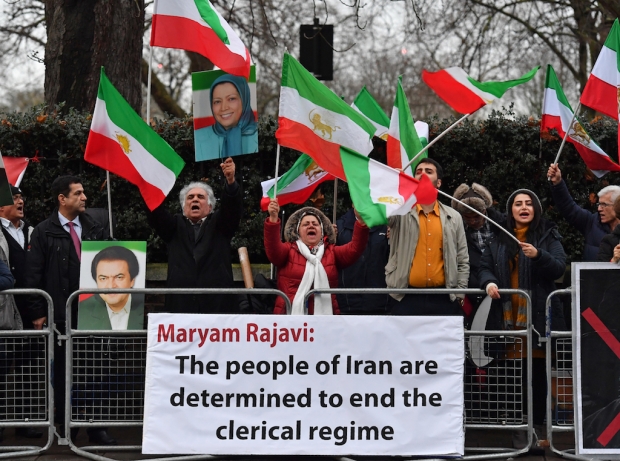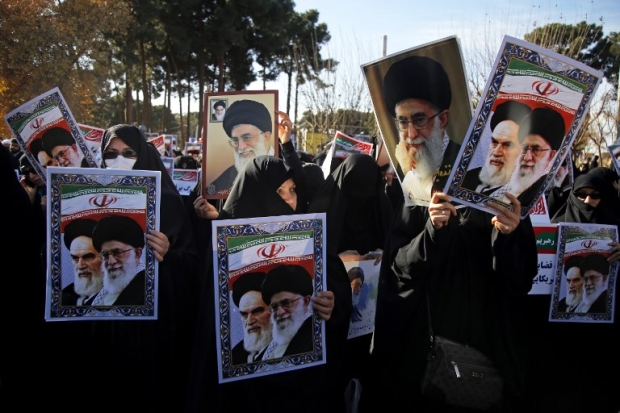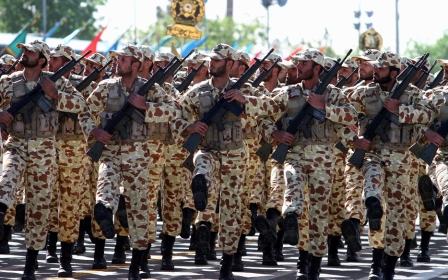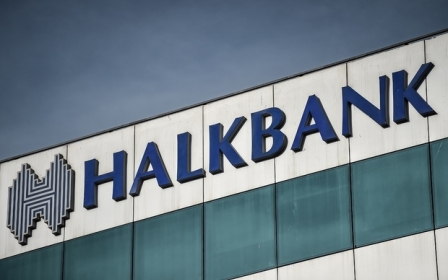'Bread, jobs and freedom': What is driving the protests in Iran?

The situation in Iran remains febrile despite claims from a senior Iranian general on Wednesday that anti-government protests had "concluded" after six days of unrest.
Islamic Revolutionary Guard Corps (IRGC) General Mohammad Ali Jafari announced the "sedition" had ended and praised "people's vigilance and preparedness" which he said "made the enemy experience another failure”.
But despite his assertions, and a number of pro-government demonstrations in recent days, the long-standing problems that sparked the protests - as well as the 21 people killed and more than 500 detained - means that any respite is likely to be temporary without concessions.
Unverified video leaked by Mujahideen e-Khalq activists shows protests in city of Amol
Footage released by activists, and unverified by Middle East Eye, appeared to show demonstrations continuing on Wednesday evening and Thursday in a number of locations including Isfahan, Hamedan and Kermanshah.
Since 2013, when President Hassan Rouhani was elected on a platform of reform, there has been deep frustration that corruption and unemployment - which currently stands at 40 percent for the young people who make up half the population - had not been tackled head-on, while money still flowed into the coffers of the IRGC to drive military operations in Syria, Lebanon, Gaza and Yemen.
At the same time, the IRGC, which brutally crushed the last significant opposition protests in 2009, are thought to own around 15 percent of the Iranian economy.
'Turning from populism to globalisation is a hazardous turn and it should have been much more slow'
- Djavad Salehi-Isfahani, economist
This combination of issues came to a head in December when - in an unprecedented move - Rouhani revealed details of his upcoming budget. Rouhani and his team long saw free-market reforms and reducing central government's role in the economy as key to both making Iran more competitive and of reducing the influence of vested interests and cronyism in the Iranian system.
In his speech on 10 December, which was broadcast live on Iranian TV, Rouhani announced large sums of money would be going to the IRGC and other religious bodies, a move that economist Djavad Salehi-Isfahani argued was an attempt to focus the ire of his supporters.
"He definitely did not hope for demonstrations, but hoped the debate would strengthen his hand vis-a-vis the conservatives in the parliament," he told Middle East Eye.
But while the largesse towards the IRGC was a point of contention, it was two other facets of the budget which provoked most outcry - the ending of direct cash transfers and a 50 percent increase in the price of oil.
The cash transfers, which began under former president Mahmoud Ahmadinejad, were originally a partial replacement for goods subsidies, and are received by around 77 million people in Iran, despite calls by Rouhani for affluent families to opt out.
A police motorcycle is set on fire in Tehran in an unverified video leaked by Mujahideen e-Khalq activists
The new budget aims to slash the payments by around $5.3bn, while handing money to the government welfare agency and the Imam Khomeini assistance committee, both of which provide money to low-income citizens on an assessed case-by-case basis.
“His budget was very bad for the lower middle-class... it is the opposite of what he should be doing," explained Salehi-Isfahani. "If you are trying to raise energy prices, you want to give people, lower-income, maybe even middle-income people, some cushion to pay for that. The money he is distributing is national wealth so people don’t expect it to be given to them conditionally or run through a bureaucracy that’s not very transparent.”
“It humbles people to go and say ‘I’m poor, I want money’ and then subject themselves to all sorts of investigations - that is, I think, much more important than fear of corruption.”
'Death to the dictator'
On 29 December, Iranian hardliners staged a demonstration in the conservative city of Mashhad. But while the aim of the original protests was to undermine Rouhani, the combination of new austerity measures and a new $11bn budget for the army - a 20 percent increase - saw the spark spread into a wildfire, targeting all pillars of the Iranian state.
Some protesters limited their calls to economic reforms and cries of "Bread, jobs and freedom" while others called for outright revolt chanting "Death to the dictator" and "We don't want an Islamic republic".
Others focused on Iran's economic support for Hamas and Hezbollah, chanting "Forget Gaza and Lebanon, I'll sacrifice my life for Iran", while a few even shouted support for the Pahlavi monarchy, which was overthrown in 1979 and now lives in exile.
Long-simmering grievances were brought out into the open as the protests spread to areas of the country inhabited by a patchwork of different ethnic and religious groups who have long been stifled under the Islamic Republic's control.
Thousands took to the street in the city of Ahwaz in Khuzestan province, which has become - as a result of the government's energy policies - the most polluted city in the world. Rural areas of Iran - which saw a sharp increase in poverty levels since Rouhani came to power - were among the strongest centres of protests (arguably in contrast to the usual epicentre of Tehran).
Labour unions - which are heavily restricted in Iran - also voiced their support for demonstrations. Non-payment of wages, sometimes for months on end, has been a major problem in the country and protests and organising against the problem has often resulted in arrests, firings and brutality from security forces.
The ongoing strike at the Haft Tapeh sugar refinery by workers who have spent months without wages following the company's privatisation has been one of the focal points of discontent that provides the backdrop to last week's demonstrations.
The city of Kermanshah, which is majority ethnic Kurdish, saw repeated demonstrations, while the armed groups linked to the Democratic Party of Iranian Kurdistan (PDKI) claimed to have killed at least three members of the IRGC in the border town of Piranshar. "Those who claim that the demonstrations are the result of a power struggle within the regime do so with the intent to delegitimise or diminish the demands of the protesters in order to conceal the realities in Iran. People want regime change and the protests are the public expression of this reality," said Loghman Ahmedi, head of foreign relations for the PDKI, speaking to MEE.
"The international community should also realise that reform in Iran means preservation and perpetuation of this oppressive regime - therefore, the international community should provide moral, political and material support for the struggle for liberty and democracy in Iran."
Among those who have also responded with glee to the protests have been the supporters of the Mujahideen e-Khalq (MEK), a long-standing Iranian opposition movement which is currently based in Albania after spending years sheltered in Iraq (something which has earned them the ire of many Iranians).
The leader of the MEK - or more specifically, its front group, the National Council of Resistance of Iran - Maryam Rajavi, was quick to praise the demonstrations and called for the overthrow of the Islamic Republic.
"Protesters are empty-handed but Khamenei fears them and their generation most because they are resolved to not relent until they overthrow the mullahs," she tweeted on Wednesday.
Groups affiliated to the MEK, which was originally an Islamo-Marxist anti-monarchy group in the 60s but fled Iran in the 80s, staged numerous demonstrations outside Iranian embassies in Europe.
Pro-MEK accounts have also been a significant presence on social media and have been responsible for spreading many videos and images of the protests in Iran, helped by the English-language skills of their activists.
But although the MEK were previously responsible for alerting the world to the existence of Iran's nuclear programme, they have also been criticised for providing less reliable information and for the indoctrination methods used in the organisation, which former members have described as akin to brainwashing.
The MEK was listed by the US as a terrorist organisation between 1997 and 2012, and the State Department said in a statement announcing its delisting: "The department does not overlook or forget the MEK’s past acts of terrorism... The department also has serious concerns about the MEK as an organisation, particularly with regard to allegations of abuse committed against its own members."
Holly Dagres, curator of The Iranist newsletter, warned against allowing groups like the MEK and the ousted Pahlavis to set the narrative for the protests abroad, pointing out they had little support inside Iran.
"While they are both different... they both advocate for the same thing: regime change," she explained.
"These current protests are no different and it's evident by their social media posts, and their attempts to lead demonstrations in Washington, in what they call 'solidarity with the Iranian protesters'."
'Coup-proof'
While long-established opponents were eager to hail the demonstrations as the beginning of a new uprising to topple the Islamic Republic, others have been cautious of overstating the significance of the past week, which has seen both pro-government protests and a notable lack of involvement from those demographics involved in the 2009 demonstrations.
At that time, activists focused around a specific grievance - the alleged rigging of the presidential election in favour of Ahmedinejad - and had distinct, visible leaders, such as Mir Hossein Mousavi.
"The Iranian government is well aware the international community is watching the protests. Having that been said, these aren't big numbers in the street," she told MEE. "I imagine they are depending on slowing the mobile phones and internet to put a stop to information sharing, which is why demonstrations have been fluctuating in size over the past week."
"If that doesn't work, they will eventually crack down."
While Iran's parliament is capable of blocking Rouhani's proposed fuel price increase, Djavad Salehi-Isfahani warned that there would need to now be a serious economic stimulus package from Rouhani if he was to further stave off instability in Iran.
“Turning from populism to globalisation is a hazardous turn and it should have been much more slow," he explained.
This article is available in French on Middle East Eye French edition.
Middle East Eye propose une couverture et une analyse indépendantes et incomparables du Moyen-Orient, de l’Afrique du Nord et d’autres régions du monde. Pour en savoir plus sur la reprise de ce contenu et les frais qui s’appliquent, veuillez remplir ce formulaire [en anglais]. Pour en savoir plus sur MEE, cliquez ici [en anglais].






